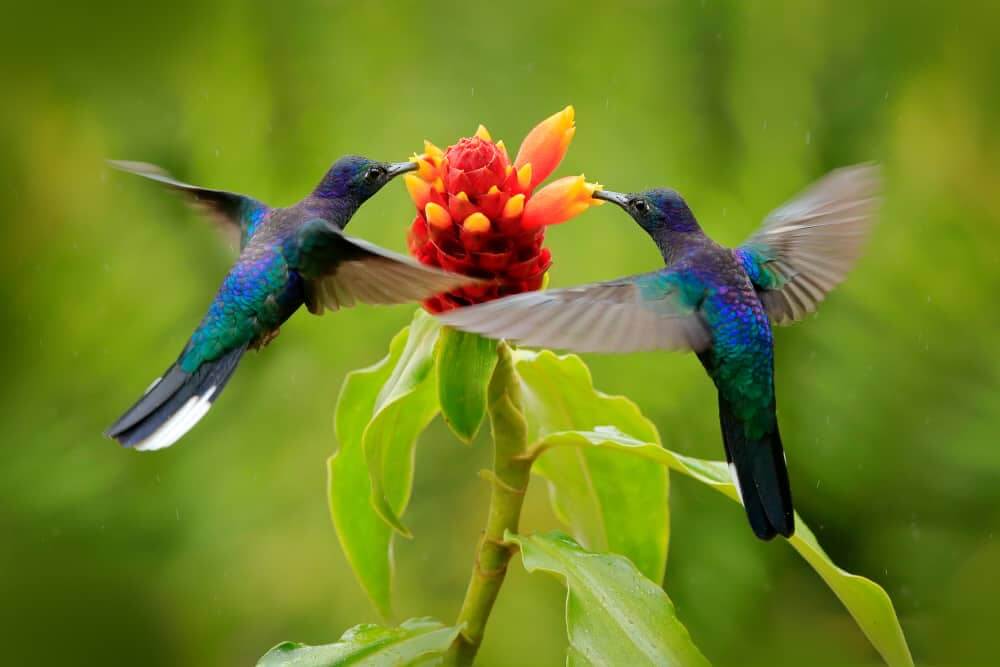It may be startling to think that hummingbirds can consume up to half the size of their body weight in a day. But if you’ve seen them in action, you’ll know how fast they can move. Their speed may be to blame as to why they need to eat every 10-15 minutes – which leads you to wonder about what food they eat. Well, you won’t have to ponder any longer on what food’s on their menu because below are some of the things they like to gravitate toward.
What do hummingbirds eat?
You may often find hummingbirds hovering over a few flowers in your garden, but their diet actually consists of a wide array of varieties. If you’re curious about what hummingbirds like to eat, here’s a quick peek at their nutrition:
1. Nectar
A hummingbird’s diet mainly consists of flower nectar because of its high sugar content. Because of their high metabolism, hummingbirds will get their energy from sucrose that’s why they can visit up to 2,000 flowers in a day. Since nectar is liquid, it can also supply their daily hydration requirements that’s why you can rarely see them drinking water.
If you want to help feed the hummingbirds when flowers aren’t in bloom, you can also create hummingbird nectar by boiling white sugar with water. Then, let the mixture cool down completely before filling it into a hummingbird feeder.
2. Pollen
Although hummingbirds don’t purposely eat pollen, they can still ingest a small amount whenever they feed on flowers. They can benefit from its protein content, but it’s not an ideal daily source of food because their stomachs can only digest less than 10%.
Since hummingbirds use their long tongues when sipping nectar from blooms, some pollen can also stick to their surface and their beaks – which will help with pollination if they decide to stick to your garden and fly around a few more flowers.
3. Ants
Similar to pollen, hummingbirds don’t actively seek out ants as their primary source of protein. They will only consume them if they’re close to their feeding area. Since ants are also drawn to sweet food sources, you’ll sometimes find them competing with hummingbirds for sustenance. If several members of their colony are already present at the site, they can quickly deplete any sugary meal within a matter of minutes.
That’s why if you’re planning on filling up a hummingbird feeder with sugar syrup, make sure it won’t be easily accessible to ants. One way is to install an ant moat since ants don’t willingly go across water.
4. Spiders
While nectar is a good source of energy, hummingbirds like to prey on unsuspecting spiders to fulfill their protein for the day. But they’d much rather prefer smaller spiders since they’re easier to catch with their beaks. It would also be ideal if the spider is out of its web so the hummingbird won’t get caught in the sticky trap.
Since spiders also tend to feed on insects, they’re also considered one of the hummingbird’s competitors for food. So if a spider is getting in the way of a hummer’s path for food, it won’t hesitate on eating it on site.
5. Tree sap
When insects and nectar are scarce during cold winter months, hummingbirds will have no choice but to get their sustenance from tree sap. They’ll usually locate holes in the trees that are pre-drilled by a certain woodpecker species, called sapsuckers. Although tree sap isn’t an ideal food for hummers, it will be enough to keep them going for a short period because they still contain a small amount of sucrose.
Because of its sweetness, ants will also be drawn to tree sap. So if a hummingbird is lucky enough to find them, it will also be able to fulfill its protein needs.
6. Fruits
If you’re drawn to the sweet aroma of ripe fruit juice, hummingbirds also won’t be able to resist their delectable scent. That’s why they’re known to take a sip on opened fruits in the wild, including oranges, bananas, cherries, and apples.
If you want to attract hummingbirds in your garden, leaving a slice of juicy fruit will also be an excellent alternative to sugar water.
7. Grape jelly
Although most of a hummingbird’s diet comes from organic sources, they would also enjoy an occasional serving of grape jelly or other types of fruit preserves. If you want to leave the hummingbirds in your garden a bit of a sweet treat, make sure to give them ones that don’t contain artificial colors and additives.
While grape jelly may surely be a hit among these speedy critters, remember to only serve them now and again. Even though hummingbirds won’t get addicted to its sweetness, they will still need a balanced nutrition of fruits, bugs, and nectar.

